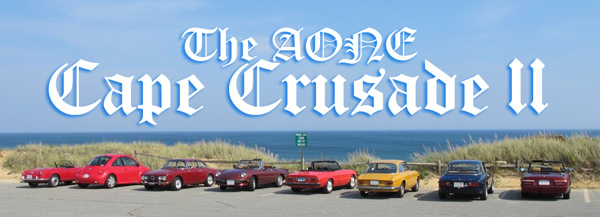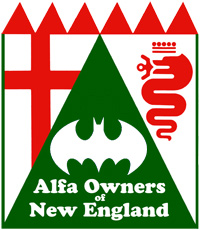|

By Phil Bostwick
Following on last year’s AONE Cape Crusade I
drive (“Batman Begins”), seventeen Crusaders driving eight
Alfa and one VW “Batmobiles” met on Saturday, October 6, at the
Dunkin’ Donuts shop in Patriot Square, Dennis, MA, to take part in
Cape Crusade II (“The Dark Knight Rises”). They were:
Deb and Dan Donovan—1988 Spider
Frank and Karen Anigbo—1969 GTV 1750
Rick and Linda Lesniewicz—1957 Spider
John and Elaine Coppola—1991 Spider
George and Paula Dolak—driving the Lesniewiczs’ 1972 Giulia Super
Roger and Karen Carlson—1974 Spider
Greg and Andrea Stidsen—1974 GTV 2000
Phil Bostwick—1972 GTV 2000
Bill and Janet Fannon—VW Beetle
The sun was shining brightly, the sky was blue with wispy white
cirrus clouds, and the wind was fair as the Crusaders enjoyed Car
Talk, coffee, doughnuts, bagels and cream cheese before receiving
their high-tech GPS maps of the route during a short drivers’
meeting. Engines were started and the group was away promptly at
10:30 a.m. They drove back roads through Harwich, past the Chatham
Airport (CQX) and into Chatham’s Main Street, where they slowly
paraded their cars for a crowd of tourists to admire.
The first stop at Chatham Lighthouse afforded them beautiful views
of the beach that was created following the breakthrough of the
barrier beach during a Nor’Easter in 1987. The first Chatham light
was a wooden structure built in 1808 to warn ships of the shoals
around Chatham. It was replaced by two brick lighthouses in 1841,
one of which fell into the beach in 1879 from erosion. The Town of
Chatham has been implementing erosion measures to protect the
remaining tower, but the time will come when it will have to be
moved or follow in the wake of its predecessors.
Back in their cars, the Crusaders drove up the Shore Road in North
Chatham, viewing magnificent seaside summer houses and the Chatham
Bars Inn. They continued north up Route 28 past Ryder’s Cove—a
beautiful sight with many boats gleaming on the sun-drenched
water—Pleasant Bay and Little Pleasant Bay. A short comfort stop in
South Orleans was followed by a slow drive though the Town of
Orleans to the Orleans-Eastham rotary.
 At
this point, the cars again took to the back roads, passing First
Encounter Beach in Eastham where, in November 1620, an exploring
party of Pilgrims in the Mayflower’s longboat went ashore
while looking for possible locations to spend their first winter and
made their first encounter with the local Indians. These back roads
ended behind the Wellfleet drive-in theatre (one of the few
remaining in the U.S.) where the Crusaders entered Route 6 to drive
to Wellfleet. At the PB Boulangerie Bistro they turned east towards
the Atlantic Ocean and followed back roads into Truro, stopping at
White Crest Beach to enjoy the view. This beach is not far from
where, in 1903, the Italian inventor Guglielmo Marconi successfully
transmitted the first transatlantic wireless message from President
Theodore Roosevelt in the U.S. to King Edward VII in the U.K. At
this point, the cars again took to the back roads, passing First
Encounter Beach in Eastham where, in November 1620, an exploring
party of Pilgrims in the Mayflower’s longboat went ashore
while looking for possible locations to spend their first winter and
made their first encounter with the local Indians. These back roads
ended behind the Wellfleet drive-in theatre (one of the few
remaining in the U.S.) where the Crusaders entered Route 6 to drive
to Wellfleet. At the PB Boulangerie Bistro they turned east towards
the Atlantic Ocean and followed back roads into Truro, stopping at
White Crest Beach to enjoy the view. This beach is not far from
where, in 1903, the Italian inventor Guglielmo Marconi successfully
transmitted the first transatlantic wireless message from President
Theodore Roosevelt in the U.S. to King Edward VII in the U.K.
Off again on back roads through Truro past Long Pond and into the
charming Town of Wellfleet, the Crusaders slowed to see the sights
of this early New England town which has been well preserved. They
then proceeded at a brisker pace up the back roads behind Wellfleet
and Truro to join Route 6 again near the Pamet River roads. They
turned off Route 6 to drive up the Shore Road on Route 6A, enjoying
a splendid view of Provincetown and the Pilgrim Tower, past the
Flower Cottages on the Bayside beach to Bradford Street in
Provincetown. When in the center of P-Town they took a slow drive
through the nation’s oldest cemetery where four of the Pilgrims who
were passengers on the Mayflower are buried.
A short drive to the Pilgrim Tower parking lot ended nearly three
hours of enjoyable sports car driving with nary a drop of moisture.
This tower is a monument to the 120 Pilgrims who departed Plymouth,
England on September 6, 1620 and endured a miserable month at sea,
arriving in Provincetown Harbor on November 11, 1620. Christopher
Jones, the captain of the Mayflower, had been blown by an
Atlantic gale far north of his planned destination—the mouth of the
Hudson River in New Amsterdam—and first attempted to sail farther
south. The shoals near Chatham caused him to return to the
Provincetown Harbor and anchor there. Following explorations of the
Bay beaches in the Mayflower’s longboat, the decision was
made to take the Mayflower to Plymouth Harbor where it
anchored on December 16, 1620, to spend the Pilgrims’ first winter.
Only half of them would be alive to celebrate the first Thanksgiving
a year later.
A short walk through the unique Town of Provincetown led us to
Bayside Betsy’s restaurant, where good New England seafood,
conversation and camaraderie were enjoyed by all. Thus ended a
perfect day of weather, sports car driving and AONE’s Cape Crusade
II.
|